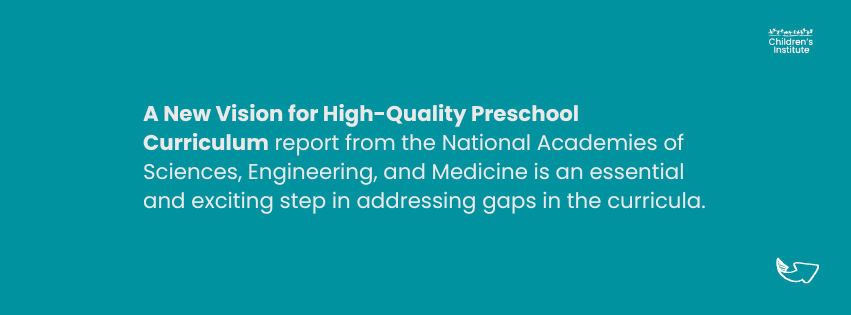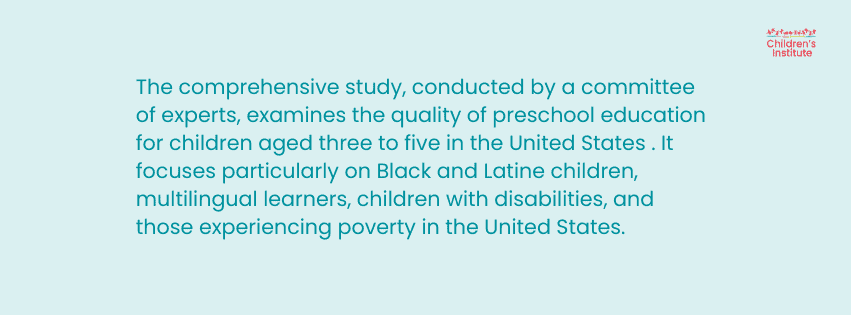Early childhood is a period of great developmental changes, setting the foundation for later learning and development.
– National Academy of Sciences, Engineering, and Medicine
Decades of research have highlighted the significant benefits of high-quality preschool education. Yet, there remains a gap in understanding the effectiveness of preschool curricula, particularly for children who are historically (and currently) underserved. In the United States, preschool programs vary widely, with curriculum being essential in creating joyful and affirming early learning environments. Even with efforts to provide supportive settings, current preschool curricula often fall short in enhancing children’s math, early literacy, and science skills, and fail to adequately support multilingual learners’ emerging bilingualism.


What's in the report?
The report outlines and emphasizes key recommendations, focusing on equity and justice-focused principles in shaping new preschool curricula development. It underscores the value of acknowledging and celebrating each child’s unique identities and strengths to fully unleash the potential of preschool education.
How can we improve the preschool landscape?
The early childhood system is complex, with diverse program offerings resulting in very different preschool experiences for children. Those furthest from opportunities often face barriers to accessing high-quality learning opportunities. When accessible, these children are frequently enrolled in underfunded programs with lower-quality instruction.
Preschool curriculum plays a key role in shaping the quality of instruction, classroom environment, and early childhood development. It outlines children’s learning objectives, uses intentional teaching methods, and determines necessary educational resources.
Research indicates that well-implemented preschool curricula can significantly reduce disparities in math, language, literacy, and social-emotional skills among children entering kindergarten. These disparities, especially for Black and Latine children and economically disadvantaged children, underscore the urgent need for effective preschool education. However, many studies focus solely on English-speaking children, overlooking the linguistic strength and potential of multilingual learners.
What should a high-quality preschool curriculum include?
High-quality preschool curricula should ensure that children have access to diverse learning experiences, offer engaging content to spark their curiosity and excitement for learning. It should also include adaptable teaching methods that cater to their strengths and individual needs.
Research indicates that a high-quality preschool curriculum should:
-
- Integrate diverse perspectives, experiences, cultures, languages, strengths, and needs of children, families, and workforce settings.
- Focus on engaging children and promoting their agency through meaningful content.
- Create and implement well-designed learning experiences with clear objectives, responsive teaching strategies, ongoing assessments, and personalized support based on children’s abilities, backgrounds, interests, and dispositions.
- Align curriculum with children’s learning processes and proven research methods, affirm children’s cultural and linguistic identities, and provide effective support for children with disabilities.
- Demonstrate measurable benefits in both school performance and overall life outcomes for children and families served.


Looking forward
Recommendations for advancing the vision
- Equity-driven preschool curricula: Guidance for content design, development, selection, and implementation
- Empowering educators: Supports and professional development for equitable and effective curriculum implementation
- Investing in equity: Funding mechanisms, policy strategies, and innovations to support selection and implementation of effective preschool curricula
- Bridging the knowledge gap: Creating an evidence base to advance curriculum development and implementation
Priorities for the future
Although we have ample evidence of the positive effects of high-quality preschool, there is limited understanding of the impact and effectiveness of the curriculum.
This report recommends a comprehensive research plan to gather evidence on preschool curricula, standardize evaluation methods, and conduct large-scale studies involving multiple research teams.
While high-quality curricula alone cannot address all early education challenges, they play a vital role in improving the quality of children’s classroom experience. High-quality preschool curricula facilitate equitable, safe, healthy, affirming, and enriching learning environments, supporting children’s success in school and beyond.
This report was long overdue, and I am hopeful and excited about what more is to come in terms of implementing the recommendations. I hope that the federal government, philanthropists, and states will find ways to ensure that we advance preschool curriculum to meet the needs of our youngest learners.
– Marina Merrill, Director of Research & Strategy, Children’s Institute
